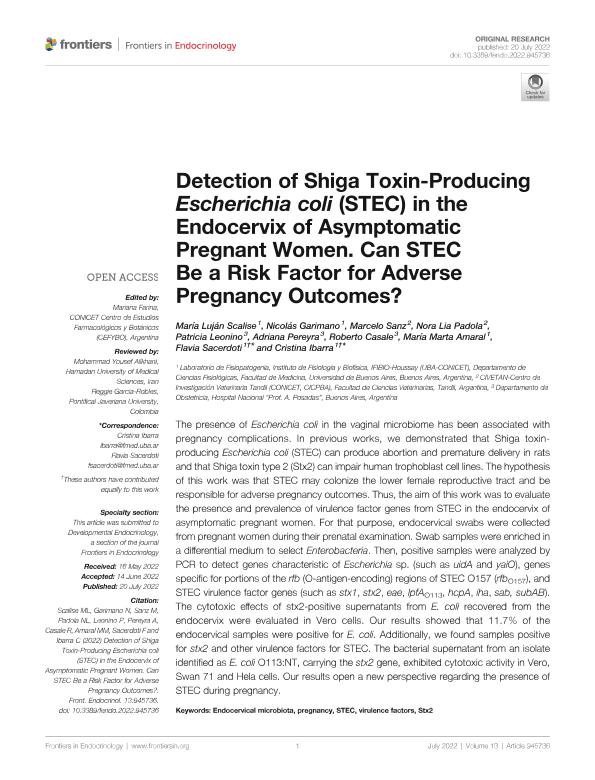Artículo
Detection of Shiga Toxin-Producing Escherichia coli (STEC) in the Endocervix of Asymptomatic Pregnant Women. Can STEC Be a Risk Factor for Adverse Pregnancy Outcomes?
Scalise, Maria Lujan ; Garimano, Nicolás Ezequiel
; Garimano, Nicolás Ezequiel ; Sanz, Marcelo Eduardo; Padola, Nora Lía; Leonino, Patricia; Pereyra, Adriana; Casale, Roberto; Amaral, María Marta
; Sanz, Marcelo Eduardo; Padola, Nora Lía; Leonino, Patricia; Pereyra, Adriana; Casale, Roberto; Amaral, María Marta ; Sacerdoti, Flavia
; Sacerdoti, Flavia ; Ibarra, Cristina Adriana
; Ibarra, Cristina Adriana
 ; Garimano, Nicolás Ezequiel
; Garimano, Nicolás Ezequiel ; Sanz, Marcelo Eduardo; Padola, Nora Lía; Leonino, Patricia; Pereyra, Adriana; Casale, Roberto; Amaral, María Marta
; Sanz, Marcelo Eduardo; Padola, Nora Lía; Leonino, Patricia; Pereyra, Adriana; Casale, Roberto; Amaral, María Marta ; Sacerdoti, Flavia
; Sacerdoti, Flavia ; Ibarra, Cristina Adriana
; Ibarra, Cristina Adriana
Fecha de publicación:
07/2022
Editorial:
Frontiers Media
Revista:
Frontiers in Endocrinology
ISSN:
1664-2392
Idioma:
Inglés
Tipo de recurso:
Artículo publicado
Clasificación temática:
Resumen
The presence of Escherichia coli in the vaginal microbiome has been associated with pregnancy complications. In previous works, we demonstrated that Shiga toxin-producing Escherichia coli (STEC) can produce abortion and premature delivery in rats and that Shiga toxin type 2 (Stx2) can impair human trophoblast cell lines. The hypothesis of this work was that STEC may colonize the lower female reproductive tract and be responsible for adverse pregnancy outcomes. Thus, the aim of this work was to evaluate the presence and prevalence of virulence factor genes from STEC in the endocervix of asymptomatic pregnant women. For that purpose, endocervical swabs were collected from pregnant women during their prenatal examination. Swab samples were enriched in a differential medium to select Enterobacteria. Then, positive samples were analyzed by PCR to detect genes characteristic of Escherichia sp. (such as uidA and yaiO), genes specific for portions of the rfb (O-antigen-encoding) regions of STEC O157 (rfbO157), and STEC virulence factor genes (such as stx1, stx2, eae, lpfAO113, hcpA, iha, sab, subAB). The cytotoxic effects of stx2-positive supernatants from E. coli recovered from the endocervix were evaluated in Vero cells. Our results showed that 11.7% of the endocervical samples were positive for E. coli. Additionally, we found samples positive for stx2 and other virulence factors for STEC. The bacterial supernatant from an isolate identified as E. coli O113:NT, carrying the stx2 gene, exhibited cytotoxic activity in Vero, Swan 71 and Hela cells. Our results open a new perspective regarding the presence of STEC during pregnancy.
Palabras clave:
ENDOCERVICAL MICROBIOTA
,
PREGNANCY
,
STEC
,
STX2
,
VIRULENCE FACTORS
Archivos asociados
Licencia
Identificadores
Colecciones
Articulos(CIVETAN)
Articulos de CENTRO DE INVESTIGACION VETERINARIA DE TANDIL
Articulos de CENTRO DE INVESTIGACION VETERINARIA DE TANDIL
Articulos(IFIBIO HOUSSAY)
Articulos de INSTITUTO DE FISIOLOGIA Y BIOFISICA BERNARDO HOUSSAY
Articulos de INSTITUTO DE FISIOLOGIA Y BIOFISICA BERNARDO HOUSSAY
Citación
Scalise, Maria Lujan; Garimano, Nicolás Ezequiel; Sanz, Marcelo Eduardo; Padola, Nora Lía; Leonino, Patricia; et al.; Detection of Shiga Toxin-Producing Escherichia coli (STEC) in the Endocervix of Asymptomatic Pregnant Women. Can STEC Be a Risk Factor for Adverse Pregnancy Outcomes?; Frontiers Media; Frontiers in Endocrinology; 13; 7-2022; 1-9
Compartir
Altmétricas



